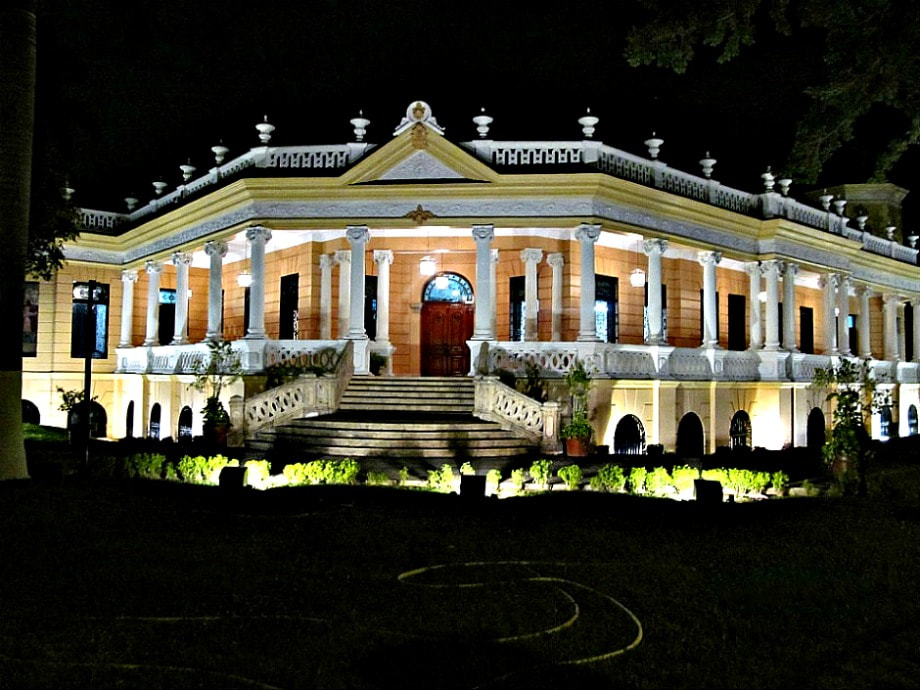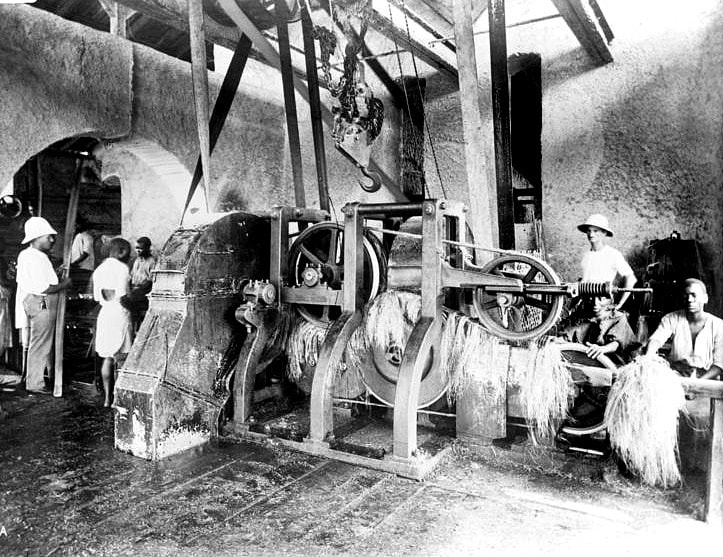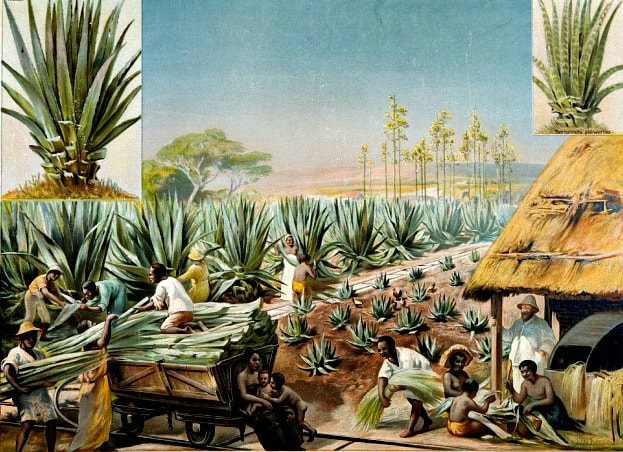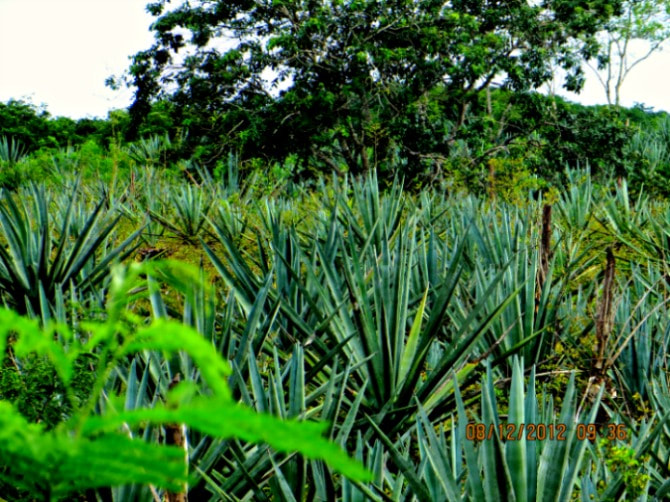|
Hacienda Temozon Sur
What are Haciendas? We will now visit the magnificent Haciendas of Yucatan, which are living proof of the fascinating history of Yucatan Mexico. Let's travel a few centuries back in time. Actually, these haciendas were built as feudal power centers for the Spanish crown. They came into existence as family owned corn and sugar cane farms and cattle ranches. This was back in the 17th century during colonial times. Years later when henequen became extremely profitable, these farms and cattle ranches would become henequen haciendas also called sisal plantations. Henequen also known as a type of agave cactus (agave fourcroydes) that grows extensively in the Yucatan Peninsula, was discovered by the ancient Mayan people of Yucatan and was grown and processed for its fiber, mainly to produce rope and twine. The dry fiber is called soskil (sohs-KEEL). This fiber is also known as sisal which is very similar to the hemp fiber. The Mayan people used it to make rope, twine, hammocks and other objects used in their homes. Today we see many other products made from this fiber (bags, rugs, shoes, place mats etc.). The European hacendados (hacienda owners) forced the local Mayans to work in the fields with very low wages or no wages at all, and established a social system based on race, just like the southern plantations did in the United States. The European landowners were the masters and the Mayans were the slaves. My First Contact with the Haciendas of Yucatan and Henequen My grandfather was a hacienda mechanic, that is, he used to fix all the machines needed in the haciendas to produce the fiber. He always had work because the machines were running day and night, and they always needed to be repaired due to continuous use. As a kid he would take me with him when I was on holiday from school, we would travel by train (there were trains in this area back then) and we would stay in each plantation for a few days when the parts were available and longer when he had to order the part. This was heaven to me, I got to take a closer look and be outdoors all the time playing with the Mayan kids whose parents worked in the hacienda henequen fields. I actually got to see these plantations working. This happened in the 1960’s, which were the last years of the henequen era. The Development of Henequen Henequen / sisal fiber was an important export product of the Haciendas of Yucatan in the 1800’s and early 1900’s, but not in a large scale. In the 1830’s Yucatan haciendas made an attempt to produce sisal in large quantities but the lack of machinery made it impossible, so the supply remained limited. It wasn’t until the late 19th century that the industrial revolution transformed the way henequen was processed, this happened when shredding machines were invented. This event triggered a boom of prosperity in Merida Yucatan and its surroundings. There was a high demand for sisal fiber during World War I (1914-1918), due to the need of rope production, countries such as the United States, France and England acknowledged the benefits and advantages of this fiber and began importing it from Yucatan. Other countries followed suit. The Haciendas of Yucatan during that time were just rural ranches, so when this opportunity arises, they became henequen / sisal plantations, and adapted their facilities, (chapels, stores etc.) to offer all the services needed for their workers. Many of these, eventually became small villages around the haciendas, and grew to be the small towns they are now. At the beginning of the 20th century there were about 1,170 working haciendas in Yucatan, today there are only about 400 left standing, most of them in ruins. Each and every one of these old plantations has its own turbulent history, but at the same time, they possess their own personality, magic and charm. Green Gold Vast fortunes were made during this period, the sisal plantations became a synonym of wealth and culture and soon henequen became known as “Green Gold”. The city of Merida grew and prospered with the new acquired wealth. Yucatan Hacienda owners started traveling to Europe where they obtained blueprints of French and Spanish style mansions, bought all their furniture there and hired the best architects to build their palatial homes in Merida Yucatan. Beautiful mansions were erected by the wealthy hacienda owners during the sisal boom. The mansions that are still standing in Paseo de Montejo are evidence and silent witnesses of past events. At the turn of the 20th century, Merida Yucatan was home to more millionaires per capita than any other city in the world. Fall of the Henequen Hacienda Empire After 70 years of being the sole exporter in the world, Yucatan’s henequen industry started to decline in the 1920’s, due to the fact that several other countries like Brazil, Cuba, Haiti Tanzania and Kenya among others, started to grow and export the fiber. Another reason was that after the Mexican Revolution of 1910, the Mexican government made some land reforms and divided these huge plantations (Haciendas of Yucatan) among the Mayan farmers, who being uneducated could not keep up with the standards of the henequen business and production began to fail. Still another reason for the downfall of this industry was the invention of synthetic fibers in the 1940´s, as a result of this, there was no demand for this product anymore. By mid 1950´s the whole sisal industry started to collapse. During this time, plantation owners went through very hard times and were forced to give up their opulent lifestyle. Sotuta de Peon the Only Live Henequen Museum Hacienda Sotuta de Peon has been restored to its former glory and grandeur. It is currently the only operating henequen plantation in Yucatan, and it offers tours (day tour and night tour) of the whole process. All the buildings, Maya houses and processing plant are part of the tour. From the moment you step inside, you literally will travel back in time a couple of centuries. The day tour includes lunch and the night tour includes dinner. By the way, the night tour is spectacular. You will be transported on wooden platforms called Trucs (trooks) which are pulled by mules over rail tracks. This was the means of transportation back in the day. It was originally used by all the hacienda workers. It offers a restaurant with delicious Mayan / Yucatecan food and an awesome blue clear water underground cenote/sinkhole, where you can take a swim before lunch. It is well worth the visit. Hacienda Sotuta de Peon Official Website Revival of the Haciendas The Haciendas of Yucatan once a symbol of splendor and prosperity, were eventually abandoned for lack of money to continue operating. For many years they were at the mercy of the elements, deteriorating as the years went by, until the 1990’s, when they started to be awakened from their sleep and brought back to life. Most of them were in very poor condition due to disuse and neglect. In the 1980's these huge properties were for sale for only $ 10,000 USD, now the price has gone up to several hundred thousand. Hacienda Mucuyche Hacienda Uayalceh Some of these former henequen plantations, have already been refurbished and turned into luxury hotels, vacation rentals, museums, restaurants or tourist attractions, some became private homes and are closed to the public, while others are still part of the jungle, waiting in line for their turn to be revived. Hacienda Temozon Sur Most of the haciendas of Yucatan were built between the 17th and 19th centuries, they are architectural works of art and are considered part of Yucatan’s architectural heritage. I am fascinated by these architectural treasures, it is really sad to see these constructions currently in such deplorable conditions, but the good news is, that once they are fully renovated and restored to their original grandeur, they become once again the beautiful glamorous rural stately constructions they once were. |




